Fox River Grove, Illinois
Fox River Grove (FRG) is a village in Algonquin Township, McHenry County and Cuba Township, Lake County, Illinois, United States. In 1919, the village of Fox River Grove officially incorporated, becoming the ninth village in McHenry County. The Grove is situated along the southern shore of the Fox River and borders the neighboring communities of Cary, Trout Valley, Lake Barrington, Barrington Hills, and Algonquin. FRG is about 45 miles northwest of the Chicago Loop, 60 miles east of Rockford, Illinois, 15 miles north of Elgin, Illinois, and 80 miles southwest of downtown Milwaukee. The population was 4,854 at the 2010 census.[3] Residents refer to themselves as "Grovers."
Fox River Grove | |
|---|---|
Village | |
 Village sign in Lions Park | |
 Flag | |
| Nickname(s): FRG, The Grove, The Great Town | |
 Location of Fox River Grove in McHenry County and Lake County, Illinois. | |
.svg.png) Location of Illinois in the United States | |
| Coordinates: 42°11′44″N 88°13′0″W | |
| Country | United States |
| State | Illinois |
| County | McHenry, Lake |
| Founded | 1919 |
| Government | |
| • Type | Village |
| • Village president | Robert Nunamaker |
| Area | |
| • Total | 1.73 sq mi (4.49 km2) |
| • Land | 1.73 sq mi (4.49 km2) |
| • Water | 0.00 sq mi (0.00 km2) |
| Elevation | 817 ft (249 m) |
| Population (2010) | |
| • Total | 4,854 |
| • Estimate (2018)[2] | 4,630 |
| • Density | 2,686.27/sq mi (1,037.15/km2) |
| Demonym(s) | Grover |
| Time zone | UTC-6 (CST) |
| • Summer (DST) | UTC-5 (CDT) |
| ZIP Code(s) | 60021 |
| Area code(s) | 847 |
| FIPS code | 17-27533 |
| Wikimedia Commons | Fox River Grove, Illinois |
| Website | www |
History
Indigenous peoples
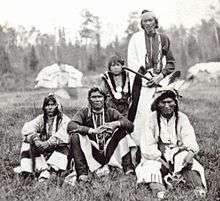
Long before the arrival of Europeans, Native Americans called the land within Fox River Grove home. The Ojibwe (also known as Chippewa) people continued to winter in the Fox River Valley into the 1860s. The women traded beadwork and purses with local settlers while the men trapped muskrat and mink, selling the pelts in nearby Barrington, Illinois. The area's proximity to Northwest Highway (Route 14), a major military and trade road, enabled such commerce to thrive. The men also made fence posts for local farmers and would "spear fish at night using torches attached to the end of their birchbark canoes."[4] When spring came, they traveled north to their summer lands in Wisconsin.[5] Between 1816 and 1833, the Ojibwe and U.S. government engaged in peace talks, resulting in several land cession treaties being signed. Eventually, all Ojibwe land in Illinois was taken by the federal government. The rapid increase of European-American settlers, coupled with pressures from the government and military, eventually forced this dynamic and proud people to leave the lands that would soon become FRG and relocate west of the Mississippi River.[6]
Czech heritage

Pioneers built homesteads in the Fox River Valley between 1830 and 1860. They were originally drawn to the area that would become Fox River Grove for its scenery and abundance of water.[7] Some of the first settlers to call the Grove home were Czechoslovakian immigrants who—by way of Chicago—established a Bohemian enclave along the Fox River. Attracted to the area for its prime fishing spots and access to 19th-century entertainment venues, Czechs built cottages among the village's hills and on the river's southern bank.[8]
In 1850, ethnically-Czech Frank Opatrny purchased 80 acres (320,000 m2) of land on the southern shore of the Fox River. Considered to be the patriarch of the village's founding family, Frank's son Eman Opatrny put FRG on the map by turning his homestead into the regionally-known Picnic Grove.[9]

The Czech community established St. John's Nepomucene Catholic Church and Cemetery on the southwest fringe of Fox River Grove in 1861. Named after a patron saint of Bohemia, the sanctuary's construction began in 1871 and was finished in 1874. Because of the church's small congregation, St. John's did not support a resident priest. Instead, a Chicago-based priest would visit the congregation once a year; for the rest of the year, Bohemian-speaking members of the church would conduct services. While St. John's stopped hosting worship services in 1914, the cemetery remains open to this day.[10]
In 1900, Edward and Francis Konopasek (a Czech couple after whom one FRG's wards is named) built the Grove's first hotel—the Hotel Fox—and established a taxi service that shuttled notables like the Chicago Mayor Anton J. Cermak and Illinois Attorney General Otto Kerner Sr. from the nearest train stations to the Grove.[8] Other notable Czech families, including the Cernockys, would continue their people's legacy of enterprise and development in the Grove into the mid-twentieth century.
While the contemporary village is known for the Luxembourgian-styled Castle Vianden, FRG was once also home to a Czech-styled castle replete with 100 stained glass windows. Built by John Legat Sr. in 1920, the castle amazed visitors as the centerpiece of what was known as Legat Gardens. While most of the castle is now dismantled, the ruins serve as a constant reminder of the Grove's former glory and Czech heritage.[9]
Resort town period
Starting in the mid-nineteenth century, Czech immigrants transformed the Grove from a backwater pioneer settlement into a vibrant resort town. Chicagoans were especially attracted to the Grove's beautiful waterfront and surrounding hilly woodlands. Staying in notable establishments such as the Hotel Fox, Chicagoans traveled to the Grove via the Illinois & Wisconsin Railroad station and livery bus shuttle in neighboring Cary, Illinois.[11]
Picnic Grove heyday
In 1899, Eman Opatrny bought his father Frank's homestead and successfully converted it into picnicking grounds. Known as the Fox River Picnic Grove, this large swath of land housed picnic plots (including sheltered areas), a shooting gallery, a horse track, six bars, a boathouse, boat docks, a dancing platform, a restaurant, a photo gallery, rowboat rentals, a bowling alley, a railroad spur track, a steam-powered excursion boat, and baseball diamonds. Trainloads of pleasure-seekers from Chicagoland would pour into the park for weekend getaways. Opatrny also built many cottages near the river's edge.

Unfortunately, the Picnic Grove suffered a major blow in 1918 as many of its buildings crumbled under the heat of a blazing fire. But, Grovers proved to be a resilient people, and the Picnic Grove picked itself back up and kept its doors open for decades. That being said, most of the attractions from the early 1900s were lost. Eventually, the railroad spur track was dismantled as well. Nevertheless, the park still held its own as prime picnicking grounds. During this time period (1920s-1930s), tourists and Grovers alike called the park Opatrny's Woods or Opatrny's Grove.
In 1942, Louis Jr. and Clara Cernocky purchased the Picnic Grove. The future of the grounds looked bright—Louis was already a successful local businessman, and Clara held important ties as the daughter of Eman Opatrny. For a time, the park—now advertised as “40 Acres of Paradise”—flourished under Cernocky leadership. The couple added more amenities, including a new dance pavilion, an air-conditioned cocktail lounge, outdoor fireplaces, a bath house, refreshment stands (including “The Krazy Movie Pop Corn Stand”), restrooms, a baseball diamond, and a 300-foot sandy beach. Additionally, a new kiddie park known as “Funland” stole the show. Among other carnival rides, it prominently featured a 10-seat Ferris wheel and a romantic, intimate "Tunnel of Love."
Vacationers continued to flock to Picnic Grove until it fell into disarray in the 1960s. While 1961 saw the opening of The Grove Marina—an entertainment center that included a restaurant, a cocktail lounge, live entertainment, a boat launch, boat slips for rent, and marine supplies for sale—the establishment was destroyed by yet another fire in the mid-1970s. From 1976 to 1993, vacancy shrouded the property. Hoping to gentrify the land, the Village of Fox River Grove obtained a grant to acquire 40 acres (160,000 m2) along the river in 1994, naming the property "Picnic Grove Park." Picnic Grove Park is one of the few public grounds left on the Fox River. The rest of the land not purchased by the village was sold to subdivision developers. Today, the park honors its glamorous past with a gazebo, grills, a playground, a picnic shelter, and picnic tables. Ghosts of its glory days, the original roadway and the concrete slab where The Grove Marina once stood still stand as reminders of an era gone by.[12]
Other resort-era establishments
Besides the Picnic Grove, FRG welcomed the addition of a luxury hotel in 1902. Christened as the Castle Pavilion and Resort Hotel, the establishment boasted windows displayed during Chicago's 1893 Columbian Exposition, the area's first player piano, and an enviable dance floor. During the 1910s, the Castle Pavilion even showed motion pictures, a novelty at the time.

In 1905, a group of ethnically-Norwegian men from Chicago established the Norge Ski Club in FRG. Utilizing its three ski jumps (the largest of which is 70 meters tall), the club hosts international competitions during the winter months. For a reasonable fee, spectators are able to watch the ski jumpers in action. The Norge Ski Club is the oldest continuously open ski club in the United States. Remarkably, the ski jumps are able to be used year-round. During the spring and summer, snow is substituted by plastic tarps that are laid along the jumps. In the colder months, snow machines are employed to ensure that the slopes have a continual dusting of snow.[13] The club made history in 2018 when three of its members (Michael Glasder, Kevin Bickner, and Casey Larson) were named to the men's U.S. Olympic ski jump team.[14] While the U.S. ski jump team failed to win a metal during the 2018 Winter Olympics, the three Norge Ski Club members are hailed as regional hometown heroes.[15]
Although it no longer stands, Fox-River Grove Inn - Louie's Place was an FRG mainstay for years. Built by Louis Cernocky Sr. at the corner of Northwest Highway and Lincoln Avenue, the establishment became a watering hole for many prominent Chicago residents and several notorious gangsters. Louie's Place also housed the Crystal Ballroom, an eight-sided dance hall built in 1923 where big-bands—including Glenn Miller, Coon-Sanders, Wayne King, Louis Panico, Fred Waring, Frankie Masters, Art Kassel, and Guy Lombardo—entertained patrons. In 1921, Cernocky added a retail section to the building, and in 1922 the plot of land was subdivided and named Cernocky's Subdivision of Block 12. In 1939, a suspicious fire broke out in the ballroom. A week later, four men saturated the ballroom with kerosene while their other two counterparts abducted the night watchman and a visiting fire marshall. These strange vandals fled by car towards Barrington, as their two planted bombs detonated at the scene of the crime. On the lam, the criminals released their captives near Palatine, Illinois. Although the explosions' resulting fire gutted the ballroom, the roof and the adjoining shops survived. The ballroom was repaired, but strangely enough, it never reopened for dancers.[16]
In 1931, Theodore "Teddy" Bettendorf began work on what would come to be known as Castle Vianden, which is located along what is now U.S. Route 14. Being an immigrant from Vianden, Luxembourg, Teddy spent 36 years building his castle in the Luxembourgian style. By 1960, the castle, which was open to visitors, had eight towers, a guard room, bugle tower, castle yard, enclosed sun porch, modern kitchen, garage, dungeon, and a wishing well. Bettendorff continued to add to his castle until his death in 1967. During the 1970s, the castle was rented out as a honeymoon retreat. The castle remains a private residence, but recently the owners of the property have been engaged in an ongoing effort to reopen the property for public enjoyment.[17]
In 1945, Fox River Grove established the first VFW post in McHenry County.
The Barberry Hills Ski Area—a ski hill complete with two rope tows, a vertical drop of 145 feet, and a ski shop—was established in the early 1960s. While the rope tows and shop are now defunct, the hill itself is still a popular winter destination for sledding.[12]
Gang-related activity
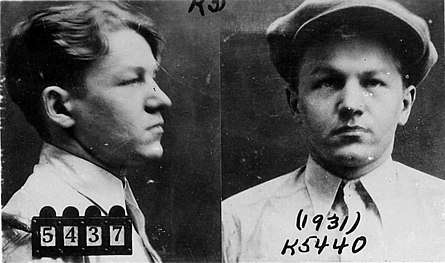
While the Grove currently boasts a low crime rate, residents of yesteryear experienced a much more turbulent reality. During the Prohibition Era, FRG embodied the metaphorical underbelly of Northwest Chicagoland's crime syndicates. From bottom-rung bootleggers to the ringleaders themselves, gangsters of all stripes staked out the Grove for both business and merry-making. Located on the Fox River, the Grove served as an ideal smuggling hub. For one, its waterways provided a quick getaway as well as a transportation route. At the same time, the village's small and relatively remote nature helped to shelter gang activity from the big-city and federal authorities. Above all, however, this criminals' playground was only made possible by Louis Cernocky Sr., a local legend to this day. Cernocky's property assets throughout FRG—along with his double-life stature as both a respected citizen and Capone gang bootlegger—allowed the operation to flourish.[18] Thanks to Cernocky, outlaws prowled the Fox River banks and frequented Cernocky's local establishments such as the Crystal Ballroom at Louie's Place—a multi-use establishment that served as a restaurant, big-band dance hall, speakeasy, and gangster hideout.[16] Importantly, members of the Dillinger Gang and Barker-Karpis Gang were regulars.[19] Notable gangster visitors to Louie's Place included Alvin "Creepy" Karpis, "Ma" Barker, Freddie Barker,[16] "Baby Face" Nelson, John Dillinger, Homer Van Meter, and Tommy Carroll. The Grove was finally released from the gangsters' grasp in 1934. Having already neutralized Dillinger in Chicago, federal agents pursued and fatally shot Baby Face Nelson on nearby Route 14 in The Battle of Barrington. With most of the ringleaders dead or behind bars, the Grove's gangster era soon came to an end.[18]
Suburban growth and the 21st century
As many entertainment businesses closed and residential development expanded, the late twentieth-century saw FRG's transformation from a raucous resort town to a sleepy bedroom community. Multiple subdivisions and shopping centers now dot the village; however, its woodsy, small-town feel still remains. No matter what, Grovers are adamant that the unique, timeless, and quirky village culture and atmosphere are here to stay.
On August 21, 2019, Fox River Grove celebrated its 100th anniversary. To celebrate the centennial, the village hosted historical tours, a carnival, and a parade during the summer of 2019.[20]
As of December 2019, FRG has become a debt-free village. According to Village President Nunamaker, this rare achievement was attained through "the accumulation of operational cost savings over the past several years and fiscally responsible decision making by the village board."[21]
Geography
Fox River Grove is located primarily in McHenry County and partially in Lake County, Illinois, along U.S. Route 14, 42 miles (68 km) northwest of downtown Chicago. It is situated on the south bank of the Fox River, which flows southwest to the Illinois River. The village of Cary is located on the north side of the river, connected to Fox River Grove by a bridge on Route 14.
According to the 2010 census, Fox River Grove has a total area of 1.78 square miles (4.61 km2), all land.[22]
Demographics
| Historical population | |||
|---|---|---|---|
| Census | Pop. | %± | |
| 1920 | 193 | — | |
| 1930 | 641 | 232.1% | |
| 1940 | 693 | 8.1% | |
| 1950 | 1,313 | 89.5% | |
| 1960 | 1,866 | 42.1% | |
| 1970 | 2,245 | 20.3% | |
| 1980 | 2,515 | 12.0% | |
| 1990 | 3,551 | 41.2% | |
| 2000 | 4,862 | 36.9% | |
| 2010 | 4,854 | −0.2% | |
| Est. 2018 | 4,630 | [2] | −4.6% |
| U.S. Decennial Census[23] | |||
As of the census[24] of 2000, there were 4,862 people, 1,677 households, and 1,294 families residing in the village. The population density was 2,929.6 people per square mile (1,130.9/km2). There were 1,734 housing units at an average density of 1,044.8 per square mile (403.3/km2). The racial makeup of the village was 95.91% White, 0.68% African American, 0.12% Native American, 1.28% Asian, 1.13% from other races, and 0.88% from two or more races. Hispanic or Latino of any race were 3.83% of the population. Common ancestries among the population include German, Polish, Italian, Irish, and English.[25] In 2017, nearly 9% of FRG's population was foreign-born.[26]
There were 1,677 households out of which 45.3% had children under the age of 18 living with them, 65.7% were married couples living together, 8.3% had a female householder with no husband present, and 22.8% were non-families. 17.7% of all households were made up of individuals and 4.9% had someone living alone who was 65 years of age or older. The average household size was 2.90 and the average family size was 3.34.
In the village, the population was spread out with 31.7% under the age of 18, 6.1% from 18 to 24, 35.0% from 25 to 44, 20.4% from 45 to 64, and 6.9% who were 65 years of age or older. The median age was 35 years. For every 100 females, there were 104.5 males. For every 100 females age 18 and over, there were 100.9 males.
The median income for a household in the village was $66,469, and the median income for a family was $78,847. Males had a median income of $59,306 versus $28,643 for females. The per capita income for the village was $28,870. About 5.2% of families and 7.1% of the population were below the poverty line, including 10.6% of those under age 18 and 8.6% of those age 65 or over.
In general, FRG has a highly educated populace, as 48.5% of the village's adults have at least a bachelor's degree.[25] Moreover, over 87% of the village's workforce are employed in white-collar positions such as managers, office workers, and salespeople. The village itself has a nearly non-existent industrial sector, meaning that most of the population works outside of city limits. That being said, just over 10% of the workforce telecommutes.
Education
Elementary and Middle School
The majority of children in the village are serviced by Fox River Grove School District #3. This district is made up of two schools: Algonquin Road Elementary School and Fox River Grove Middle School.
Algonquin Road Elementary School (also known as ARS) provides a Kindergarten through 4th grade educational curriculum and boasts a 12:1 student-teacher ratio.[27] In 2019, 52% of ARS students were deemed "proficient" in math, and only 47% tested at or above Illinois's set proficiency level in reading.[28]

Two-hundred and five students in 5th through 8th grade attended Fox River Grove Middle School (FRGMS) in 2019. 53% of FRGMS students were proficient in math in 2019, and 55% were proficient in reading. The middle school's student to teacher ratio was 14:1.[29]
High Schools
Most students in Fox River Grove attend Cary-Grove Community High School located across the Fox River in neighboring Cary. Home of the Trojans, Cary-Grove is known throughout the state for its football and girls' volleyball teams. In addition to students in Cary and Fox River Grove, Cary-Grove also services students from eastern Crystal Lake and areas of Trout Valley, Oakwood Hills, and Barrington.[30]
Lake County Schools
A small number of Fox River Grove students residing in the exclusive communities of Victoria Woods and Hunter's Farm attend schools in Barrington Community School District #220.[30]
Fox River Grove Memorial Library


In 1936—with the blessing of village leadership and a $65 donation from the Norge Ski Club—the FRG Library Board was established.[31] Since then, the Fox River Grove Memorial Library (FRGML) has become one of the village's premiere municipal entities. Located just steps from the Fox River Grove Metra station, the current library building boasts wide windows that allow natural light into the space. These same windows serve as a creative space for FRG's youth. Each season, tots and adolescents alike are allowed to use washable paint to decorate the windows with playful characters, holiday greetings, and positive sayings. The building's front facade is surrounded by a wall of rock slabs, erected in honor of the victims of the 1995 bus-train collision. The memorial is meant to serve as a sitting and reading area. Additionally, the library's official name was changed from Fox River Grove Public Library to Fox River Grove Memorial Library following the accident.
Today, the library is a source of education, community enrichment, and hometown pride. The library offers citizens books, tabloid magazines, audio books, CDs, VCRs, and DVDs, and as well as non-traditional items like video games, board games, fishing poles, STEM kits, umbrellas, and snow scrapers. Moreover, FRGML provides passes to local attractions, Wi-Fi access, printing and scanning services, coloring pages for children, as well as exam proctoring.[32] Those wanting to immerse themselves into the community and FRG culture can join the library's book club or running club.
FRGML serves as an archive of the Grove's history. The library's historical collection includes community scrapbooks, Czechoslovakian Newsletters, photographs, VHS tapes on FRG history, and binders on the Norge Ski Club, balloonport, schools, and local businesses.[31]
The library's backbone is the volunteer-supported, non-profit Friends of the Fox River Grove Memorial Library (FOL) organization. Established in 1996, the group's members pay dues and are responsible for maintaining the village's two Little Free Libraries and running bi-yearly book sales. Twenty years after the organization's founding, the FOL's president was awarded with a flower and pepper-laden basket at the Northern Illinois Regional Friends meeting hosted by the Crystal Lake Library in 2016. Inclusive and friendly, the FOL welcomes new members with open arms.[33]
Neighborhoods
Despite being a small and intimate village, Fox River Grove is home to several distinct neighborhoods. With varying home sizes and differing vibes, the village offers neighborhoods that are sure to fit a plethora of desires and lifestyles.[34]
Castle Estates
Snaking along the main drag of Concord Avenue, Castle Estates offers some of the oldest and cheapest homes in the village. Perfect for investors and yuppies, Castle Estates provides many unique real estate opportunities.
Chalets of Fox River Grove
This tiny hamlet within the village contains two condominium buildings. Being situated mere steps from the Fox River Grove Metra Station, the Chalets are perfect for young professionals who want easy access to the jobs and nightlife of Chicago.
Country View
Country View is a small neighborhood situated in the northern part of Fox River Grove. Most homes in the neighborhood are 2,000 square feet on average and typically have four bedrooms and two bathrooms. Country View is best suited for buyers looking for a decidedly suburban neighborhood.
Crystal Creek
Tiny Crystal Creek consists of a small cluster of homes on Bloner Parkway. Close to Spring Creek and Algonquin Road Elementary, Crystal Creek is the perfect fit for families who value nature and education.
Foxmoor
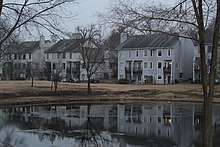
Located southwest of Route 14, Foxmoor is a well-established neighborhood made up of single-family homes. The first homes in Foxmoor were erected in the early 1980s. Consisting of winding streets, cul-de-sacs, and an abundance of children roaming in the streets, Foxmoor is a suitable neighborhood in which to raise a family. As the village's largest neighborhood, Foxmoor truly is the heart and soul of Fox River Grove.
Hillview Estates
Large plots of land and plenty of nature are the hallmarks of Hillview Estates. Located on the western side of town, Hillview Estates is just a couple blocks from the banks of the Fox River.
Hunter's Farm
Hunter's Farm was built between 2000 and 2003. The village's most expensive homes are found in Hunter's Farm—most are priced at the half-million range. Ritzy and high-class, this neighborhood is ideal for the particular and exclusive buyer.
Konopasek
Boasting Cape Cod style homes on quarter-acre plots, Konopasek is one of the village's most historic neighborhoods (with the earliest homes being built in the early 1900s). Konopasek homes are reasonably-priced, and many offer water access and views of the Fox River.
Maplewood Meadow Estates
When one pictures a typical, family-friendly neighborhood in the suburban Midwest, Maplewood Meadow Estates (MME) should come to mind. Homes in MME are perfect for both young couples ready to fill their nest as well as empty-nesters who are enjoying their golden years.
Picnic Grove
Winding along Barberry Trail, Picnic Grove is a quaint neighborhood on the north side of the village. The area was first developed in 1996, and it is home to some of Fox River Grove's largest houses. The neighborhood's development sparked the Picnic Grove controversy of 1994.
Ski Hill
The appropriately-named Ski Hill neighborhood is located minutes away from the renowned Norge Ski Club. Large homes built between 2006 and 2008 fill Ski Hill. Those who enjoy watching or participating in winter sports would acclimate nicely to this neighborhood.
Venetian Gardens
Radiating from the banks of the Fox River, Venetian Gardens consists of reasonably-priced, single-family homes. While waterfront properties elsewhere can go for millions of dollars, middle-class families wanting to be near the water can find their own slice of paradise in the Venetian Gardens. Some waterfront properties even have boat docks and stunning views of the Cary skyline.
Victoria Woods
Just north of Half Day Road, Victoria Woods is an exclusive neighborhood on the edge of Fox River Grove. Picturesque, single-family homes line the female-named streets (Heather Ct., Primrose Lane, Jasmine Way, Camilla Place, etc.).
Vorisek
On the crest of the Fox River, Vorisek offers quarter-acre lots with three-bedroom, two-bath homes. The neighborhood provides a unique, "North Woods" feel.
Welch's
Nestled in the crux between Route 14 and Half Day Road, Welch's is an established neighborhood. With large lots and dotted among wooded glens, Welch's offers a countryside escape from the more urban areas of Fox River Grove.
Parks and recreation




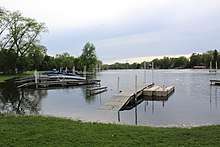

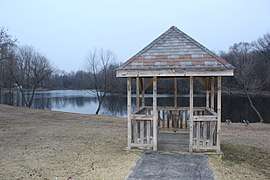
Over 100 acres in Fox River Grove are classified as public parks and open space. Between the village's 11 parks, access to playgrounds, basketball and volleyball courts, Port-A-Johns, sledding hills, baggo (cornhole) sets, soccer and baseball fields, picnic areas, fishing spots, hiking areas, and an ice skating area are made available to residents and visitors.[35]
The village's small size has inhibited it from being able to support an official park district, so recreational activities are planned and administered by the volunteer-run Fox River Grove Rec Council. Sporting opportunities offered by the Council include a men's basketball league, an adult volleyball league, and a youth soccer program. Youth baseball, softball, and basketball leagues are administered by Cary-Grove organizations.[36]
One of the most charming aspects of living in the Grove is being able to attend several community events—most of which take place on FRG parkland. For instance, during the annual Fireworks Celebration (always on the Saturday after the 4th of July), Fox River Grove shoots off fireworks from 30-acre Picnic Grove Park.[37] Also in July, Picnic Grove Park serves as the "battlefield" for the Fox River Grove Fire District's water fights. During this community event, residents watch the village's firefighters take on other departments in a family-friendly water battle.[37] In 2017, Foxy's River Snack Shack set-up shop in Picnic Grove Park. Upon opening, the beloved food truck gained a following and is known throughout the village for its ice cream, hot dogs, hamburgers, burritos, tacos, and cheesy nachos.
The FRG Rec Council hosts its annual Fox Chase 5K in Stanger Park. Runners and walkers—young and old—are welcome to attend. A youth mile alternative is offered for youngsters.[38]
Lions Park, being nestled along a bend of the Fox River, provides scenic views of Cary as well as a home for native flora and fauna. This waterside park is the site of Lions Fest, a yearly September festival in which Fox River Grove residents gather to converse and eat roasted corn. The lesser-known Arts & Crafts Fair is also hosted at Lions Park each July.[37] In 2019, the village celebrated its centennial. The highlight of this celebration was a temporary carnival installed at Lions Park. The carnival instilled bliss and pride in Grovers by treating them to a Ferris wheel, parade, and an appearance by the Oscar Mayer Wienermobile.[39] Continuing on with the hot dog motif, Grovers enjoying Lions Park are sometimes rewarded by a visit from the "hot dog boat." This tiny craft—decked-out to look like a river boat—occasionally trawls the river looking for ravenous patrons. Stocked with hot dogs, soda, and ice cream novelties, one only has to give the captain a shout and wave for him to steer the craft to shore.
| Park name | Acres | Facilities | Neighborhood(s) |
|---|---|---|---|
| Picnic Grove Park | 30 | Sled hill, playground, volleyball court, Port-A-John | Picnic Grove |
| Foxmoor Park | 30 | Fishing holes, hiking trails, gazebo | Foxmoor |
| Victoria Woods Park | 22 | Grassy knoll | Victoria Woods |
| Hunters Farm Park | 15 | Baseball field, soccer field, playground | Hunters Farm |
| Old Hunt Park | 9 | Sled hill, baseball field, soccer field, snack shack, Port-A-John | Foxmoor |
| Spring Creek & Maple Parks | 9 | Fishing zone, hiking trail, picnic area | Hillview Estates, Konopasek, Maplewood Meadow Estates, Venetian Gardens |
| Algonquin Road & Stanger Parks | 7 | Soccer field, basketball court, ice rink (seasonal), sewage/runoff ditch, hiking trail, playground | Foxmoor |
| Lions Park | 6 | Fishing zone, picnic area, shelter, volleyball court, playground, sandy beach, basketball hoops, Port-A-John | Vorisek |
| Foxmoor Jaycee Park | 3.5 | Fishing hole, soccer field, basketball hoops, baseball field, shelter, picnic area, hiking trail, playground | Foxmoor |
| North River Parks | 1 | Fishing zone, playground, picnic area | 3 individual parks hugging the river's bank |
Climate and natural environment
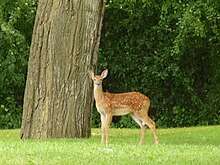
.jpg)

Like the rest of Northern Illinois, Fox River Grove has a humid continental climate (Köppen climate classification Dfa) with cold winters and hot and humid summers. The village's topography includes flat prairies, temperate broadleaf and mixed forests, rolling hills, oak savannas, the Fox River, creeks, and several ponds.
With its many parks and diverse array of ecosystems, FRG is a haven for wildlife. White-tailed deer, raccoons, rabbits, gray squirrels, and chipmunks are common mammals seen throughout the village. Rats and mice are sometimes found in FRG homes and trash bins, and feral cats have been seen roaming the streets. Elusive species like bobcats, opossums, woodchucks, red foxes, and coyotes call the more isolated parts of the village home.
The abundance of trees, thickets, and water attract birds to the Grove. Canada geese and mallards swim and feed in the river and local ponds, and a pair of swans used to live in Foxmoor Park. Sparrows, mourning doves, finches, and cardinals congregate at bird feeders, while robins bop around while pursuing worms. Spotted sandpipers and palm warblers have been spotted on the river's bank. Hawks are known to hunt and build their nests near the village's oak savannas, and—while rare—bald eagles can occasionally be seen flying above the Fox River.
Bullfrogs and toads mate and spawn in the village's waters while bluegills, catfish, largemouth bass, smallmouth bass, muskies, and walleyes swim in the river's depths.[40] Occasionally, garter snakes are spotted slithering among the underbrush.
Entertainment

Fox River Grove is primarily a residential municipality; however, the village offers its citizens and tourists a noteworthy spread of entertainment options.
One renowned FRG establishment is King Pin Lanes bowling alley. Built in 1924, King Pin Lanes became the first bowling alley to open in McHenry County. For decades, the alley hosted bowling leagues and attracted patrons from as far away as Chicago—many of whom would stop at the alley during a visit to FRG's Picnic Grove. King Pin Lanes is still in operation today, offering bowling enthusiasts an old-timey experience; as a tribute to the golden era of bowling, scores must be kept by hand.[41]
In 2012, the village legalized slot machines. Since then, several gambling dens have established themselves in FRG and transformed the village into a regional hub for games of chance. Slots can be found at King Pin Lanes, Dotty's, Tinman's Pub, and New China Restaurant—all of which line FRG's entertainment strip along Route 14.
Out-of-towners from nearby Cook County are drawn to the lower sales taxes in Fox River Grove (located within Lake & McHenry Counties).[42] Home to one of the region's 19 Armanetti Beverage Marts, FRG rightfully lays claim to a staple liquor supplier within Northeastern Illinois. With roots reaching back to the Prohibition Era, Armanetti's gifts its patrons with a link to Chicagoland's intriguingly booze-laden past. Top Shelf Liquor, the local rival, likewise fulfills customers' liquorous needs. Those craving tobacco and/or vape products can acquire their desired items in a few boutiques hugging Route 14. Locals and tourists who are interested in body art can patronize Toltek Tattoo, the village's only tattoo and piercing studio.[43]
FRG is home to a diverse array of restaurants, including establishments specializing in Mexican, Asian, fast food, pub, pizza, and breakfast fare. Despite being relatively small, the village provides a culinary experience sophisticated enough to please even the most picky palate.
Stick's Pub & Grill offers karaoke to patrons every Thursday night.

Boating and fishing have long been extremely popular activities in the Grove. Taking this nautical spirit to heart, the village boasts a marina on the Fox River. At the Fox 14 Marina, boaters can take advantage of vessel rentals, sales, and storage, a boat maintenance shop, a boat launch, a gas dock, and other shiply services. Moreover, the village's marina is situated within walking distance to FRG's entertainment strip, giving boaters on the Fox River the opportunity to make the Grove a port-of-call destination.
Shoppers are able to explore the village's two shopping centers: Stone Hill Center and Foxmoor Crossing. The centers contain several stores (Tuesday Morning and Walgreens) and chain restaurants typical of American suburbs (McDonald's, Subway, Jimmy John's, Panera, and Dunkin'). Jewel-Osco serves as the Grove's premier grocery store. In 2020, a Culver's replaced the historic Mr. Beefy's hot dog shack on Northwest Highway.[44] Offering more than just shopping, Stone Hill Center annually hosts "Rock the Routes", a summer music festival. Live tunes coupled with the aroma of craft beers and local cuisine make for a relaxing outing, Grove-style. Family-appropriate activities, including a car show and kids' games, help to keep everyone engaged.[37]
For sports aficionados, ski jump competitions can be viewed at the world-renowned Norge Ski Club. Additionally, residents can cheer on the Cary-Grove High School Trojans as they compete against other local high schools in a wide range of athletic events. National sports games can also be viewed at the village's many sports bars.
Renowned Grovers Dave and Laura Mack have, for decades, captivated the community with their festive outdoor displays for the Halloween and Christmas seasons. Curious folk are welcome to drive through the bedazzled "Mack Manor" property and view its myriad of inflatables, animatronics, props, and light arrangements. In October, live actors dressed as spooky skeletons and ghouls prowl the property, allowing guests to experience thrills and frights from behind the safety of their windshields. For a fully immersive experience, visitors can dial their radio to a custom station in order to hear background noises that complement the attraction's visuals. The Macks have also kept pace with the times by including pop culture references in their displays, such as a Pennywise the Dancing Clown dummy and a hidden Fortnite llama piñata in their haunting display. Entry into the estate is free, allowing people from all socio-economic backgrounds the opportunity to engage in the seasonal festivities. That being said, donations can be playfully placed into the maw of a ferocious monster. The Christmas display typically runs from early December until New Year's Eve where it culminates in a celebratory fireworks display. Notable crowd-pleasers in the Christmas set-up include a replica of the shapely leg lamp from A Christmas Story as well as a dancing Santa on the porch. Complimentary peppermint-flavored treats are gifted to patrons upon entering the property.
Transportation


The main artery running through Fox River Grove is U.S. Route 14, also known as Northwest Highway. Those traveling north on Route 14 can access the cities of Cary, Crystal Lake, and Woodstock; cities along Route 14 found south of the village include Barrington, Palatine, Arlington Heights, Mount Prospect, Des Plaines, Park Ridge, and Chicago. Illinois Route 22 also passes through FRG, connecting the village to North Barrington, Lake Zurich, Long Grove, Lincolnshire, the Tri-State Tollway, Bannockburn, and Highland Park. Moreover, Algonquin Road allows Grovers quick access to the villages south of FRG including Algonquin, Lake in the Hills, and Carpentersville. FRG residents can make use of the MCRide system, a dial-a-ride service that offers rides between several McHenry County municipalities.[45]
FRG has one Metra station along the Union Pacific Northwest line which connects Harvard, Illinois to Chicago's Ogilvie Transportation Center. Non-express trips between the Grove and Chicago take about 70 minutes.
Newsworthy events
Picnic Grove controversy
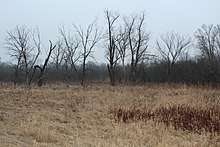
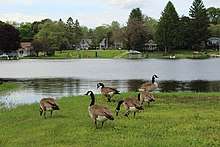
During the economic prosperity of the 1990s, Fox River Grove—like many bedroom communities around the United States—found itself in the midst of a housing boom. In 1994, 6 out of 7 of the village's trustees voted to allow a luxury housing development to be built on 62 acres within the 102-acre Picnic Grove—a stretch of land straddling the banks of the Fox River. Despite having the overwhelming support of the Board of Trustees, the decision was deemed controversial by many members of the community.[46]
Environmentalists, concerned parents, and those wanting to preserve the quaint nature of Fox River Grove formed a grass-roots activist group called the Grove Alliance. Strongly motivated and backed by 1,300 village citizens, the group presented the Board of Trustees with a lengthy report condemning the construction plans. When dismissed by the Board, 150 activists stood in solidarity to peacefully protest the decision.
The Grove Alliance was a diverse coalition of citizens. Environmentally-conscious members claimed that Picnic Grove's oak savannas were home to the endangered and elusive red-shouldered hawk. Parents stated that increasing housing in the village would swamp the already-crowded ARS and FRGMS. Other activists expressed concern over the potential for increased traffic.
Proponents of development argued that building a new subdivision would benefit the village by increasing revenue from property taxes and by improving the village's water and sewage networks. Moreover, Picnic Grove's developers attempted to appease village parents by promising to build two additional classrooms in the village.
Despite the Grove Alliance's efforts, the housing development was built. While the controversy rocked village politics by causing passionate and robust debate, civility was maintained, saving the integrity and good nature of FRG.
Fox River Grove level crossing accident
On October 25, 1995, a Metra passenger train, running express towards Chicago, collided with a Cary-Grove High School school bus, killing seven high school students. The accident brought reform and increased safety standards nationwide for signaled rail crossings located very near street and highway intersections which are regulated by traffic signals, also known as interconnected crossings.
New China Restaurant fire of 2013

In January 2013, a grease fire ignited and raged through the kitchen of FRG's New China Restaurant, resulting in $150,000 in damages.[47] After the flames died down, the restaurant was unable to reopen because it lacked the funds necessary to get the space up to code. In response, Grovers rallied together and individually donated money to the restaurant while New China's owners took advantage of the village's facade grant program. In November 2014, New China's reconstruction was completed, allowing the restaurant to open its doors to a flood of hungry and elated Grovers. Strong support from the community was shown as New China saw a spike in sales, serving "400 to 600 egg rolls a day, 300 mai tais a night, and going through hundreds of pounds of chicken each week."[48] Today, New China remains an anchor business in the Grove's historic downtown and, like a phoenix risen from the ashes, serves as a constant reminder to villagers of the hope and charity their community is founded on.
Landmarks
 FRG sign welcomes tourists to the village
FRG sign welcomes tourists to the village Local children adore the "Polliwog Playground" in Picnic Grove
Local children adore the "Polliwog Playground" in Picnic Grove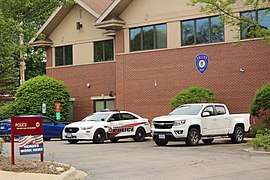 Fox River Grove Police Department
Fox River Grove Police Department Sled hill at Picnic Grove Park
Sled hill at Picnic Grove Park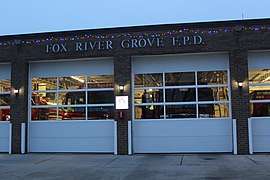 Fox River Grove Fire House
Fox River Grove Fire House ARS Eagles baseball field sign
ARS Eagles baseball field sign Carved hoot owl overlooks the Lions Park shoreline
Carved hoot owl overlooks the Lions Park shoreline Iconic River Inn Motel along Route 14
Iconic River Inn Motel along Route 14 Beloved FRG water tower
Beloved FRG water tower Oak savanna at Picnic Grove Park
Oak savanna at Picnic Grove Park Old Glory flying high above the peninsula at Lions Park
Old Glory flying high above the peninsula at Lions Park
References
- "2017 U.S. Gazetteer Files". United States Census Bureau. Retrieved Dec 29, 2018.
- "Population and Housing Unit Estimates". Retrieved September 28, 2019.
- "Geographic Identifiers: 2010 Demographic Profile Data (G001): Fox River Grove village, Illinois". U.S. Census Bureau, American Factfinder. Archived from the original on February 12, 2020. Retrieved December 10, 2012.
- | "Milwaukee Public Museum: Ojibwe History"
- | "Encyclopedia of Chicago: Fox River Grove, IL"
- | "Encyclopedia of Chicago: Ojibwa"
- "History of Fox River Grove"
- Hanna, Janan (June 12, 1993). "BOHEMIA MEETS MAYBERRY ON THE FOX RIVER". Chicago Tribune. Chicago. Retrieved January 9, 2020.
- | "Fox River Grove Historic Walking Tour"
- | "HISTORY OF ST. JOHN NEPOMUCENE CHURCH AND CEMETERY"
- | "Encyclopedia of Chicago: Fox River Grove, IL"
- | "The Digital Research Library of Illinois History Journal: Fox River Picnic Grove (Amusement Park) in Fox River Grove, Illinois. (1900 to Mid-1970s)"
- "Norge Ski Club"
- "Norge Ski Club trio officially named to Olympic ski jump team". Northwest Herald. Crystal Lake, IL. January 25, 2018. Retrieved January 14, 2020.
- Armstrong, Jim (February 10, 2018). "Michael Glasder, Kevin Bickner and Casey Larson fall short in normal hill ski jumping; German Andreas Wellinger wins gold". Chicago Tribune. Chicago. Retrieved January 14, 2020.
- "Louis' Place Crystal Ballroom"
- "About The Bettendorf Castle"
- Rowland, Brett (June 24, 2009). "'Public Enemies' and Fox River Grove's notorious history". Northwest Herald. Crystal Lake, IL. Retrieved January 14, 2020.
- Girardin, George Russell; Helmer, William J.; Mattix, Rick (2005). Dillinger: The Untold Story. Bloomington, IN: Indiana University Press. p. 340. ISBN 0-253-21633-8.
- "Fox River Grove's Centennial Celebration"
- "Fox River Grove becomes a debt-free community". Daily Herald. Arlington Heights, IL. December 4, 2019. Retrieved May 22, 2020.
- "G001 - Geographic Identifiers - 2010 Census Summary File 1". United States Census Bureau. Archived from the original on 2020-02-13. Retrieved 2015-08-03.
- "Census of Population and Housing". Census.gov. Retrieved June 4, 2015.
- "U.S. Census website". United States Census Bureau. Retrieved 2008-01-31.
- "Fox River Grove Profile"
- "Fox River Grove, IL Heritage: Foreign-Born Population"
- "Algonquin Road Elementary School"
- "Fox River Grove Middle School"
- "Fox River Grove Schools"
- Fox River Grove Memorial Library: Local History
- Fox River Grove Memorial Library: Services
- Friends of the Library
- "Neighborhoods of Fox River Grove"
- "Parks & Recreation"
- "Fox River Grove Rec Council"
- "Events & Attractions"
- "Fox Chase 5K"
- Buchman, Cassie (August 24, 2019). "Fox River Grove rings in 100 years with centennial celebration". Northwest Herald. Crystal Lake, IL. Retrieved January 13, 2020.
- "Department of Natural Resources: Fox River"
- Stearns Burgess, Nancy (June 9, 1996). "KING PIN LANES ROLLS INTO HISTORY OF FOX RIVER GROVE". Chicago Tribune. Chicago. Retrieved December 26, 2019.
- | "Illinois Tax Rate Database"
- | "Fox River Grove Business Directory"
- Bachman, Cassie (August 1, 2019). "Mr. Beefy's, Culver's land sale closes; demo could begin soon". Northwest Herald. Crystal Lake. Retrieved January 17, 2020.
- "MCRide"
- Hlotke, Suzanne G. (September 20, 1994). "FOX RIVER HOMES OKD OVER PROTEST". Chicago Tribune. Chicago. Retrieved December 25, 2019.
- Bustos, Joseph (January 2013). "Grease fire breaks out at New China in Fox River Grove". Northwest Herald. Crystal Lake, IL. Retrieved January 9, 2020.
- Rowland, Brett (November 17, 2014). "With help, New China Restaurant reopens in Fox River Grove after fire". Northwest Herald. Crystal Lake, IL. Retrieved January 9, 2020.
- | "Fox River Grove restaurant chemical spill sends 3 to hospital"


